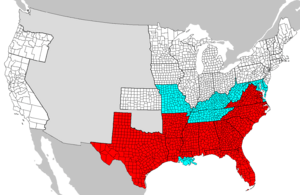Emancipation Proclamation facts for kids
The Emancipation Proclamation was a special order from U.S. President Abraham Lincoln. He issued it to free slaves in 10 states during the American Civil War. These were states that were still fighting against the United States in 1863.
This order didn't free all slaves right away. That's because the Confederacy (the states fighting the Union) still controlled those areas. But it did immediately free about 20,000 slaves. As the Union army moved into Confederate states, nearly all 4 million slaves (from 1860) gained their freedom.
Before 1865, only states could end slavery within their own borders. So, Lincoln used his power as commander-in-chief (leader of the military) to issue the Proclamation. He saw it as a way to help win the war.
The Proclamation made freeing slaves a main goal of the Civil War. It also made it harder for countries like England and France to support the Confederacy. As Union soldiers advanced, thousands of slaves were freed daily. Many didn't wait; they ran away to claim their freedom.
Five slave states, called the Border States, stayed loyal to the Union. Lincoln did not have the power to free slaves in these states. So, the Proclamation did not apply there. It also didn't apply to Tennessee or parts of Virginia and Louisiana already controlled by Union forces.
Contents
What the Proclamation Did
The Emancipation Proclamation was announced in two main parts.
First Announcement
On September 22, 1862, President Lincoln announced that in 100 days, he would free all slaves. This would apply to areas not yet under the Union's control.
Second Announcement
On January 1, 1863, Lincoln named the ten states where the proclamation would apply. These states were Texas, South Carolina, North Carolina, Georgia, Alabama, Mississippi, Arkansas, Virginia, Kentucky, and Louisiana.
The five Border States where slavery was still legal were not named. This is because they had stayed loyal to the Union and were not fighting against the U.S. government. Tennessee was also not named because Union forces had already taken control there. Some counties in Virginia that were forming the new state of West Virginia were also specifically left out. So were some areas around New Orleans in Louisiana.
The Proclamation stated that: "all persons held as slaves within any State or designated part of a State, the people whereof shall then be in rebellion against the United States, shall be then, thenceforward, and forever free."
This meant that the U.S. government, including the military, would protect the freedom of these people.
Only a small number of slaves who were already behind Union lines were freed right away. But as Union forces moved forward, almost all four million slaves eventually gained their freedom. Some former slaves even joined the Union army to fight for their freedom.
Ending Slavery Forever
Before the Civil War ended, some of the Border States that were not covered by the Proclamation decided to end slavery on their own. While the Proclamation freed many slaves, it did not make slavery illegal everywhere.
Because of this, Lincoln supported a constitutional amendment to ban slavery across the entire country. The Thirteenth Amendment made slavery illegal everywhere in the United States. It was passed in late 1865, about eight months after Lincoln was assassinated.
Related pages
Images for kids
-
A painting of a black man reading a newspaper with the headline "Presidential Proclamation/Slavery" (1983)
-
This is a memorial to the 54th Massachusetts Infantry of the Union Army, which contained many ex-slaves
-
Two ex-slave children who were probably freed by Lincoln's work, circa 1870
-
The moment the proclamation was signed, portrayed by Lee Lawrie in Lincoln, Nebraska
-
Eastman Johnson (American, 1824–1906) – A Ride for Liberty – The Fugitive Slaves (recto), ca. 1862
-
A printed poster recruiting men of color to enlist in the U.S. military after the Emancipation Proclamation in 1863 (Philadelphia, Pennsylvania).
-
Emancipation from Freedmen's viewpoint, illustration from Harper's Weekly 1865
-
President Barack Obama views the Emancipation Proclamation in the Oval Office hung above a bust of Martin Luther King Jr. in 2010
See also
 In Spanish: Proclamación de Emancipación para niños
In Spanish: Proclamación de Emancipación para niños
















